Chapter 14: Incomplete records
Chapter learning objectives
Upon completion of this chapter you will be able to:
- explain and illustrate the calculation of profit or loss as the difference between opening and closing net assets
- explain techniques used in incomplete record situations:
- calculation of opening capital
- use of ledger total accounts to calculate missing figures.
- use of cash and/or bank summaries
- use of given gross profit percentage to calculate missing figures.
1 Incomplete records
When you are preparing a set of accounts, it is likely that youmay not have all of the information available to you to complete a setof financial statements.
It is likely that you may have an incomplete ledger or control accounts system.
If this is the case, you will have to use the best information that is available to you and 'guestimate' any missing figures.
There are a number of different ways which we can use to calculate missing figures and balances, such as:
- Accounting equation method
- Opening capital calculations
- Balancing figure approach
- Ratios – mark up and margin
- Lost inventory methods
2 Identification of profit figure using the accounting equation
If a business has recorded very little information of itstransactions it may only be possible to calculate net profit for theyear. This can be done using the accounting equation as follows:
Net assets = Capital + Profit – Drawings
Therefore:
Change in net assets = Capital introduced + Profit for the period – Drawings for the period.
NB: Net assets = Assets – Liabilities

 Test your understanding 1
Test your understanding 1
Andy Carp’s statement of financial position at 31 December 2004shows that his fishing business has net assets of $5,000. The statementof financial position as at 31 December 20X5 shows that the businesshas net assets of $8,000. Andy’s drawings for the year amounted to$2,500 and he didn’t introduce any further capital in that year.
What profit is made by Andy Carp in the year ended 31 December 2005?
A $5,500
B $500
C $10,500
D $7,500
NB: Net assets = Assets – Liabilities

3 Identification of individual account balances within financial statements
- In most cases a business will keep limited accounting records from which it is possible to prepare a full set of financial statements. You may be asked to calculate any of the balances within these financial statements.
- In these types of questions the opening asset and liability balances will be given together with details of transactions during the year.
- Opening capital can be calculated as:
Opening assets – Opening liabilities
 4 The balancing figure approach
4 The balancing figure approach
The balancing figure approach, using ledger accounts, is commonly used in the following way:

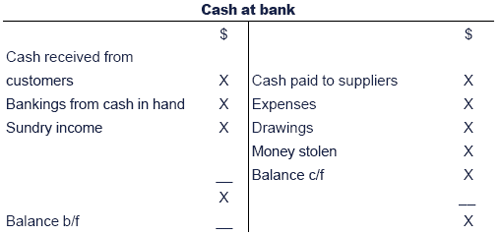
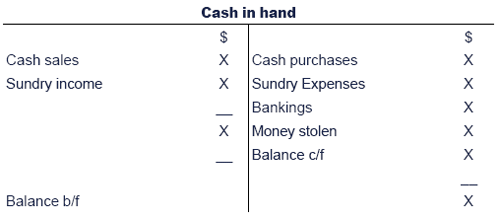
In the case of receivables and payables, you may need to use totalreceivables and total payables accounts where information given cannotbe split between cash and credit sales and purchases:



 Test your understanding 2
Test your understanding 2
Suppose that opening receivables for B Rubble’s business are$30,000. There have been total receipts from customers of $55,000 ofwhich $15,000 relates to cash sales and $40,000 relates to receipts fromreceivables. Discounts allowed in the year totalled $3,000 and closingreceivables were $37,000.
What are total sales for the year?
A $65,000
B $50,000
C $47,000
D $62,000


 Test your understanding 3
Test your understanding 3
The opening payables of Dick Dastard-Lee’s business are$15,000. Total payments made to suppliers during the year were $14,000.Discounts received were $500 and closing payables were $13,000.
What are total purchases for the year?
A $16,500
B $16,000
C $12,000
D $12,500

Questions may require you to calculate ‘missing’ incomestatement figures, for example rent and rates values, from a list ofinformation including payments and opening/closing accruals andprepayments.
To calculate the missing value for each expense use either:

 Test your understanding 4
Test your understanding 4
The following information relates to Ivor Big-Head’s business:

What are the income statement charges for electricity and rent for the year?



 Test your understanding 5
Test your understanding 5
On 1 January Elma Fudd’s bank account is overdrawn by $1,367.Payments in the year totalled $8,536 and on 31 December the closingbalance is $2,227 (positive).
What are total receipts for the year?
A $4,942
B $7,676
C $9,396
D $12,130


 Test your understanding 6
Test your understanding 6
On 1 January, Daisee Chain’s business had a cash float of $900.During the year cash of $10,000 was banked, $1,000 was paid out asdrawings and wages of $2,000 were paid. On 31 December the float was$1,000.
How much cash was received from customers for the year?
A $12,900
B $14,900
C $13,100
D $6,900

 5 Ratios – mark up and margin
5 Ratios – mark up and margin
Gross profit can be expressed as a percentage of either sales or cost of sales:
E.g.
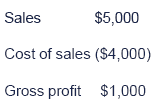
- Gross profit margin = (1,000/5,000) x 100 = 20%
- Mark up = (1,000/4,000) x 100 = 25%

 Test your understanding 7
Test your understanding 7
Padraig O’Flaherty has sales of $1,000. He makes a margin of 25%.
What is the cost of sales figure?
A $200
B $800
C $750
D $250


 Test your understanding 8
Test your understanding 8
Ratios
Lorna McDuff has cost of sales of $600 and a 25% mark up.
What is her sales figure?
A $750
B $800
C $250
D $200

Using margin and mark up
An exam question will often provide you with margin and cost ofsales or mark up and sales. You will then be required to calculate theremaining figures in the income statement. This can be done using thefollowing ‘relationship’ columns:

Therefore, if we know the mark up or margin percentage and one ofthe figures in the income statement, we can calculate the remainingfigures in the income statement.

 Test your understanding 9
Test your understanding 9
Jethro Longhorn can tell you the following with regard to his business:
Margin 5%
Opening inventory $800
Closing inventory $600
Purchases $2,840
Complete Jethro’s income statement with the above figures.

6 Cost of lost inventory
- In incomplete record questions, inventory may have been lost – probably due to a fire or flood.
- Closing inventory that has not been lost is subtracted from cost of sales because by definition, the inventory has not been sold in the year.
- Lost inventory has not been sold in the year and therefore also needs subtracting within cost of sales.
- Therefore, to work out the cost of lost inventory, complete the trading account from the information given and then lost inventory can be calculated as a balancing figure.

 Test your understanding 10
Test your understanding 10
Jack Spratt provides the following information about his business:

What is the cost of inventory lost in the fire?
A $12,000
B $9,000
C $69,000
D $5,667

Double entries for inventory and lost inventory
Actual closing inventory is posted by:
Lost inventory will still be credited to the income statement sothat it is removed from cost of sales. However, the debit side of theentry will depend on whether or not the lost inventory has been insured:


 Test your understanding 11
Test your understanding 11
Fred lost his entire inventory in a fire. His unsigned insurancepolicy is still in the pocket of his good suit. Fred has supplied youwith the following information:
Mark up 25%
Sales $10,000
Opening inventory $2,000
Purchases $7,500
Prepare Fred’s income statement and show the journal to record closing inventory.

7 Reconstruction of full financial statements
Although you will not face an exam question of this length, thefollowing illustration will help you to see how a full set of financialstatements can be reconstructed using the methods within this chapter.

 Illustration 1 – Reconstruction of full financial statements
Illustration 1 – Reconstruction of full financial statements
Malcolm is a retailer, selling stationery. He does not keep afull set of records. The following records have been extracted from hisbooks.

He also has the following cash and bank transactions for the year ended 30 September 2005.
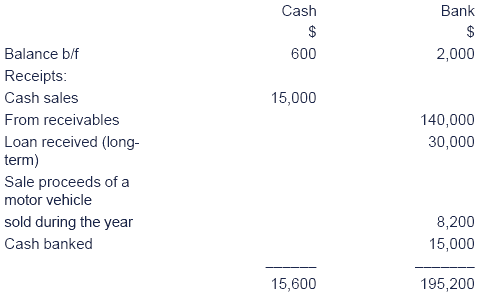
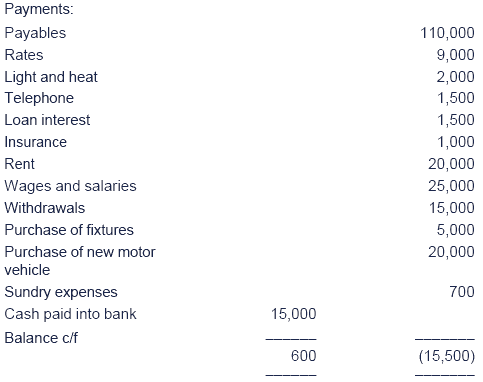
The following further information is available:
(1) The loan was received at the beginning of the year and is entitled to 5% interest pa.
(2) The motor vehicle disposed ofduring the year had cost $10,000 and the accumulated depreciation on itas at 30 September 2004 was $1,900.
(3) Discount received during the year amounted to $500.
(4) Goods amounting to $1,000 at cost were withdrawn by Malcolm during the year.
(5) The depreciation policy is as follows
(a)Fixtures and fittings, 20% pa on a straight-line basis.
(b)Motor vehicles, 10% pa on a reducing-balance basis.
(6)The allowance for receivables is to be provided at 5% pa on the closing receivables.
(a)Prepare Malcolm’s income statement for the year ended 30 September 2005.
(b)Prepare Malcolm’s statement of financial position as at 30 September 2005.


 Completing a full set of financial statements
Completing a full set of financial statements
Solution
(a) Malcolm’s income statement for the year ended 30 September 2005
(b) Malcolm’s statement of financial position as at 30 September 2005
(W1)
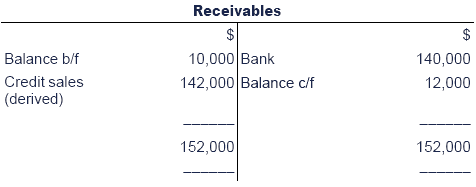
(W2)

(W3)
(W4) Allowances for receivables
(W5) Fixtures and fittings

(W6) Motor vehicles

(W7) Capital as at 30 September 2004
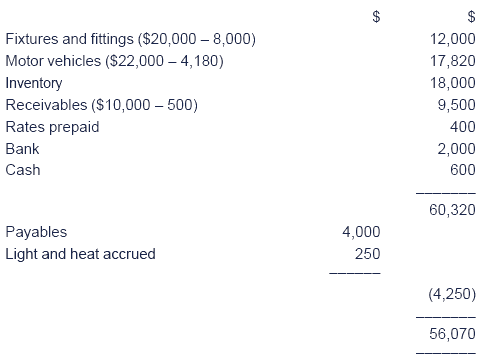
(W8) Drawings
Chapter summary
Test your understanding answers

 Test your understanding 1
Test your understanding 1
The correct answer is A
Change in net assets = Capital introduced + Profit for the year- Drawings for the year
$8,000 – $5,000 = 0 + Profit for the year – $2,500
Profit = $3,000 + $ 2,500
= $5,500


 Test your understanding 2
Test your understanding 2
The correct answer is A

Receivables
Total sales = $50,000 + $15,000 = $65,000
OR



 Test your understanding 3
Test your understanding 3
The correct answer is D



 Test your understanding 4
Test your understanding 4
The correct answer is B
Income statement (extracts):
Expenses
Electricity (–250 + 1,000 + 300) = $1,050
Rent (300 + 2,000 – 400) = $1,900


 Test your understanding 5
Test your understanding 5
The correct answer is D
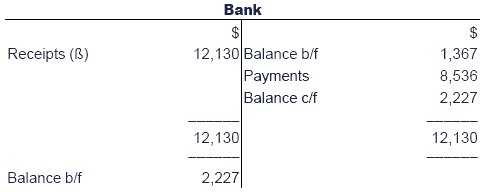


 Test your understanding 6
Test your understanding 6
The correct answer is C
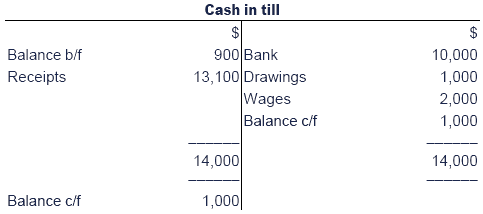


 Test your understanding 7
Test your understanding 7
The correct answer is C
Gross profit: $1,000 x 25% = $250
Cost of sales:



 Test your understanding 8
Test your understanding 8
The correct answer is A
Gross profit: $600 x 25% = $150



 Test your understanding 9
Test your understanding 9
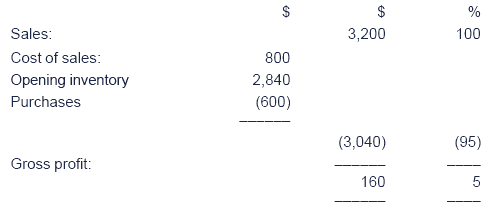


 Test your understanding 10
Test your understanding 10
The correct answer is B
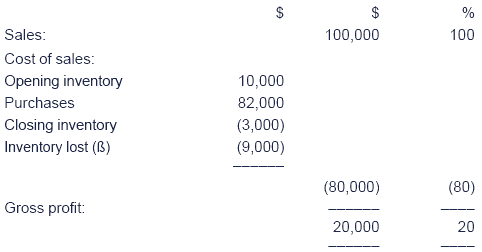


 Test your understanding 11
Test your understanding 11

Being the recording of uninsured inventory destroyed by the fire.

|
Created at 5/24/2012 3:36 PM by System Account
(GMT) Greenwich Mean Time : Dublin, Edinburgh, Lisbon, London
|
Last modified at 5/25/2012 12:53 PM by System Account
(GMT) Greenwich Mean Time : Dublin, Edinburgh, Lisbon, London
|
|
|
|
 |
Rating
:
|
 Ratings & Comments
(Click the stars to rate the page) Ratings & Comments
(Click the stars to rate the page)
|
 |
Tags:
|
|
|
|
|